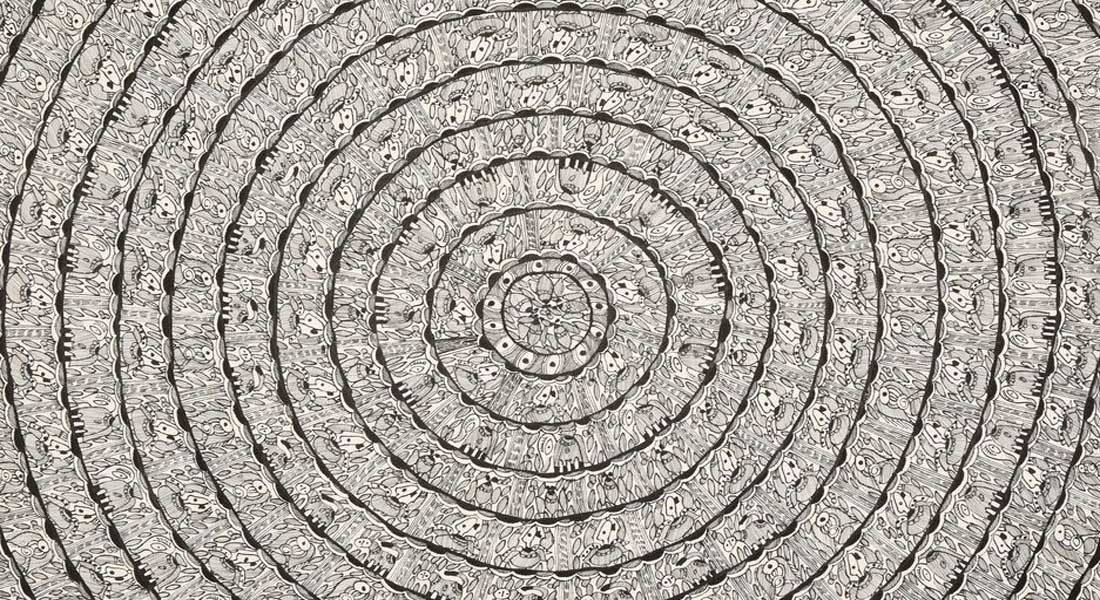Tattooing is an age-old tradition of India in general and tribal societies in particular. In Northern and Central India, tattooing is popularly known as ‘Godna.’ “Tattooing is found in primitive tribal groups like the Saharias of Rajasthan, Buksas and Rajis of Uttaranchal, Kelas, Kumeubas, Paniyans and Todas of Tamil Nadu, Chenchus, Konda Reddis and Kuttiya Khands of Andra Pradesh, Abuj Marias, Baigas, Hill Korwas, Bharias, and Sahariyas of Madhya Pradesh and Chhattisgarh, Asurs, Birhors, Korwas and Mal Pahariyas of Jharkhand, Bondos, Juangs, Mankirdias and Sauras of Orissa, Lodhas and Birhors of West Bengal, Riangs of Tripura and the Tribes of many other states.” Among Kerala tribes Kurumbars, Irulars, Mudugars, Paniyans, Kattunaykans, Vettakurumans, Mannans, Muthuvans, Kanikkars tattooing is generally in vogue.
Tattoo Patterns
The different types of tattoo patterns act as identification marks that distinguish individual from individual, one ethnic group from another and one culture area from another. The women of the Oraon tribe, living in Surguja and Raigarh districts, get three lines tattooed on their foreheads. The Bhil women have a characteristic bird like tattoo at the side angle of both eyes. This gives them a permanent long-lashed look. The bird and scorpion motif is found specially amongst the Bhils. The characteristic tattoo of the women of the Baiga tribe is a ‘V’ shaped mark at the centre of their forehead between the eyebrows.
Some common and popular patterns of tattoo are the staple choice of the tribals. They depict floral and geometric designs, horses, elephants with riders, scorpions, peacocks, and tribal myths. Generally, girls tattoo flowers, while small girls prefer single dots at various places of the face or a horse-shoe like half circle over their forehead. Elderly ladies like tattoos of scorpions, deers, peacocks and flower like patterns on ankles, hands and shoulders.
Godna Painting
Contemporary Indian society has continued the pre-historic rock art tattoos as their popular tradition. Noteworthy Godna paintings are Devar Godna of Rajanandgaon district of Chhattisgarh, Godi godna of Surguja district of Chhattisgarh, badi Godna of Dindori district of Madhya Pradesh and Madhubani Godna of Mithila region of Bihar, done by Brahmins and Kayasthas to picturize the sacred Hindu Mythological texts. Paswans design animals, minerals and vegetables on their huts rather than divinities.
Madhubani Godna artists use natural colours derived from bark, leaf, flowers, seeds of plants and trees, clay and cow dung. They wash handmade papers in cow dung and dry it before using it as a canvas for painting. They have started using synthetic colours easily available in the market. Now, colours obtained in powdered form are used after mixing these with goat milk.
Women in Jamgala, in Lakhanpur district of Sarguja, like Safiano Bai, Ramkeli and Budh Kunwar, have revived traditional Godi godna, by mixing natural pigments procured from the forest with acrylic paint to stabilize these on fabrics. Ladies of Jamgala now make table cloths, napkins, kurtas, saris, wall hangings and even bed sheets. Uma Devi from Rajanandgaon district of Chhattisgarh is a noted Devar Godna artist. Santhi Batti of Dindori district of Madhya Pradesh has made indelible mark on badi Godna.
Modernisation has influenced the Godna art and artists to a great extent. Tattooing has shifted from body to paper, cloth and canvas. Female tattooists have played an important role in the dissemination of Godna painting in India and abroad through exhibitions and workshops.
—
Source: Indian Culture / Lalit Kala Akademi
—
Disclaimer: The opinions expressed within this article or in any link are the personal opinions of the author. The facts and opinions appearing in the article do not reflect the views of Folkartopedia and Folkartopedia does not assume any responsibility or liability for the same.
Folkartopedia welcomes your support, suggestions and feedback. If you find any factual mistake, please report to us with a genuine correction. Thank you.

